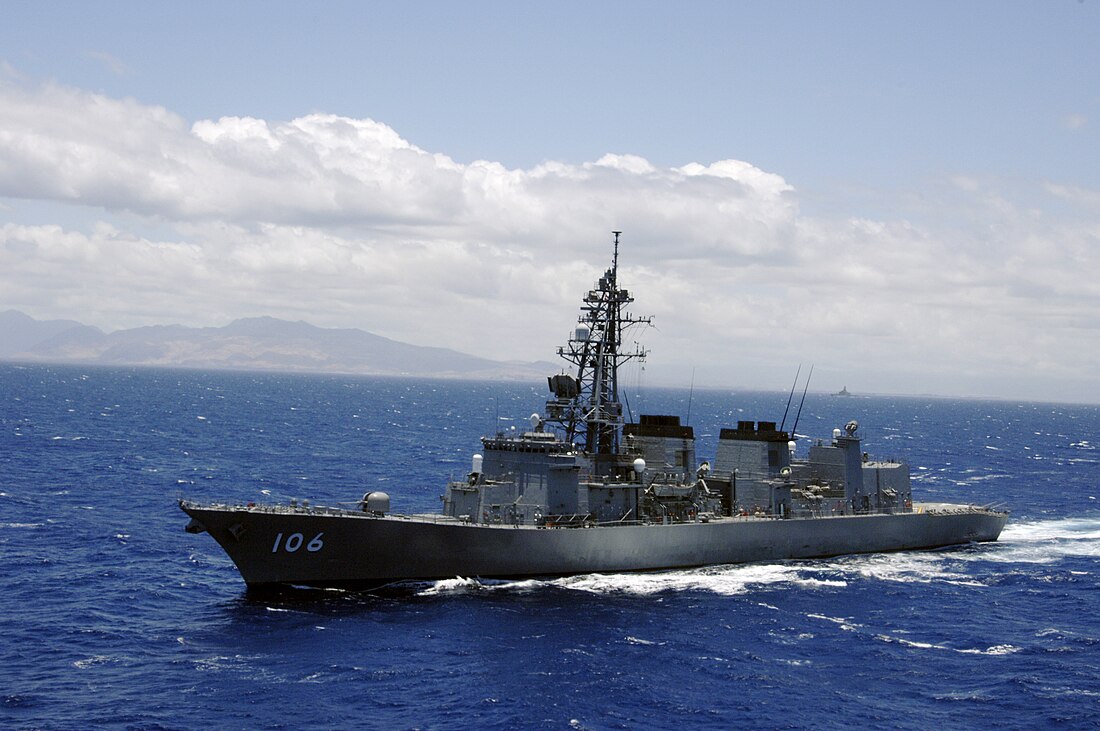Top Qs
Timeline
Chat
Perspective
JS Samidare
Destroyer of the Japan Maritime Self-Defense Force From Wikipedia, the free encyclopedia
Remove ads
JS Samidare (DD-106) is the sixth Murasame-class destroyer of the Japan Maritime Self-Defense Force (JMSDF). She was commissioned on 21 March 2000.[1]
Remove ads
Design
In the Murasame class, the hull design was completely renovated from first-generation destroyers. In addition to increasing the size in order to reduce the underwater radiation noise, both the superstructure and hull were inclined to reduce the radar cross-section. However, there is no angled tripod mainmast as on American Arleigh Burke-class destroyers because of the heavy weather of the Sea of Japan in winter. The aft was designed like a "mini-Oranda-zaka" as with the Kongō class to avoid interference between helicopters and mooring devices.[2] Destroyers built under the First Defense Build-up Plan, including the former Murasame class, adopted a unique long forecastle style called "Oranda-zaka".
The engine arrangement is COGAG, the same as in the Asagiri class, (the Murasame's predecessor class) but a pair of engines were updated to Spey SM1Cs, and the remaining pair were replaced by LM2500s, as used in the Kongō class.[2]
Remove ads
Construction and career
Summarize
Perspective
Samidare was laid down on 11 September 1997, by Ishikawajima Harima Heavy Industries at Tokyo as part of the 1995 plan and launched on 24 September 1998. Commissioned on 21 March 2000, the vessel was incorporated into the 4th Escort Corps and deployed to Kure.
Samidare was deployed to Somalia in 2009 as part of multinational anti-piracy efforts to protect ships passing through the Indian Ocean alongside Sazanami.[3]
Samidare destroyer participated in Japan-US-India Joint Training (Malabar 2019) from 26 September to 4 October 2019. Exercises were carried out in the sea and airspace from Sasebo to the south of the Kanto region. The JMSDF also sent other escort vessels JS Chōkai and JS Kaga, supply vessel JS Ōmi, and P-1 patrol aircraft. USS McCampbell, a P-8A aircraft, and a submarine from the United States Navy, INS Sahyadri, INS Kiltan, and a P-8I aircraft from the Indian Navy participated in anti-submarine warfare training, anti-submarine warfare training, conducted anti-water shooting training, anti-aircraft shooting training, and offshore replenishment training.[4]
On 16 October of the same year, Samidare conducted communication training using radio with the Chinese Navy destroyer Taiyun (which was scheduled to participate in the JMSDF Fleet review on 14 October, but canceled due to Typhoon Hagibis) in the Pacific Ocean south of Kanto region. This was the third Japan-China goodwill training for the JMSDF, the previous being in December 2011.[5]
On 4 May 2022, Samidare deployed to Djibouti for anti-piracy operations.[6] In late May, Samidare was relieved by Harusame.[7]
On 20 June 2024, Samidare arrived at the Port of Colombo, Sri Lanka, as part of a formal visit. Following the completion of the official engagement, the vessel departed from the island on 22 June 2024.[8]
Samidare again arrived at the port of Colombo on 17 November on a formal visit. The vessel is captained by Commander Naoki Koga, and will depart the island on 19 November 2024.[9]
Remove ads
Gallery
- Samidare departing Pearl Harbor on 5 July 2006.
- Samidare replenished by USNS Rainier on 22 February 2016.
- Samidare alongside USS Carl Vinson on 8 March 2017.
- Samidare alongside USS Carl Vinson on 8 March 2017.
- Samidare on 20 October 2019.
- Samidare underway, 19 April 2021
- Samidare conducts training with USS Gonzalez, 28 June 2022.
Citations
References
Wikiwand - on
Seamless Wikipedia browsing. On steroids.
Remove ads










